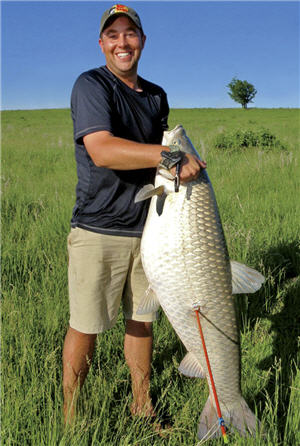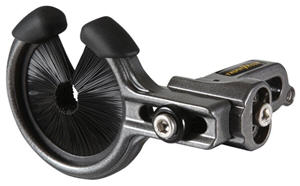
Bowfishing has always been a great pastime for off-season archers, but in recent years, it has absolutely exploded in popularity. It's fun and easy, and anyone can have an absolute blast doing it!
Equipped with either a low-price set up or an advanced bowfishing reel combo kit, you'll benefit the lakes, rivers, and streams by removing invasive species and rough fish—and in most states, all you need is a valid fishing license to bowhunt anytime of the year. Though you can buy specialized equipment, it's not absolutely necessary. A second-hand recurve or compound will do just fine, as long as you have the right arrows and points.

|
Bowfishing is just what it sounds like: shooting fish with a bow and arrow. Carp are the most common target, and removing them from the ecosystem benefits both native fish, which carp compete for food with, and plants, which carp starve of sunlight by kicking up mud with their powerful bodies. An overpopulation of carp in a small lake or pond can destroy the entire ecosystem—they're sort of like the feral hogs of the water. And regardless of the old wives tales, carp can be great eating too, if it's prepared right. Other fish commonly pursued by bowfishers include longnose gar, alligator gar, Asian carp, bighead carp, catfish, and buffalo.
![]() Tip: Read this aricle, Help the Environment, Try Bowfishing and learn what bowfishermen are doing to help our lakes and reservoirs.
Tip: Read this aricle, Help the Environment, Try Bowfishing and learn what bowfishermen are doing to help our lakes and reservoirs.
![]() From the Smithsonian.com article: Bite Back Against Invasive Species at Your Next Meal; When Eat MO Carp, a Missouri-based marketing initiative run by University of Missouri associate professor Mark Morgan, conducted a blind taste test pitting Asian carp against Missouri’s state fish, catfish, the carp won by a landslide.
From the Smithsonian.com article: Bite Back Against Invasive Species at Your Next Meal; When Eat MO Carp, a Missouri-based marketing initiative run by University of Missouri associate professor Mark Morgan, conducted a blind taste test pitting Asian carp against Missouri’s state fish, catfish, the carp won by a landslide.
Morgan’s organization considers Asian carp a menu item instead of a just a local pest. In a 2015 editorial for the Missourian, Morgan called using local carp a “win-win” that both creates demand and addresses a dire ecological issue. Morgan has served carp chili and tacos to Mizzou students, offered free samples at a grocery store, served as a food vendor for a bowfishing tournament and even persuaded a local brewery to throw an Asian carp-themed food event. by Jennifer Bilock, Smithsonian.com
 |
| AMS Bowfishing Retriever Pro Bowfishing Reel |
![]() Tip: Watch videos explaining how to prepare Aisan Carp here
Tip: Watch videos explaining how to prepare Aisan Carp here
Let's Talk About Bowfishing Gear
You can pick up an old compound at a flea maket, or even a hand-me-down recurve; but the ideal setup is something like the AMSBowfishing® Fish Hawk Compound Bowfishing Package (It comes with just about everything you need but the fish.) And FYI: it's probably not a good idea to use your deer hunting set-up—bowfishing can be messy.
The reel is the most important piece of equipment in your setup—it's your connection between you and the fish, and it's how you get it back to the boat. Give yourself a better chance of boating that trophy by spending a little money in this category. AMSBowfishing® Retriever Pro Bowfishing Reel is really the best choice for any setup, giving smooth shots and plenty of power when bringing in big fish. Many large-capacity spincast reels will work just fine as well, like the tried and true Zebco 33, or Muzzy's Xtreme Duty Bowfishing Reel, designed specifically for hunting big fish.
 |
| J.P. Morris with a 81-pound Grass Carp |
Spool up your AMS reel with 400# Dacron line, or your spincast reel with 200# braid, and you'll almost never lose a fish to a broken line.
Arrows and Points
Arrows: Fiberglass arrows are fiberglass arrows. There are plenty of choices out there, and you'll need AMS Safety Slides on every one. Buy them pre-installed, or put them on yourself, but USE THEM, because arrow snapback can be nasty without them.
Points: This is another area where you want to spend a little more for a better quality product. For big or soft fish, Innerloc 3-barb Grapple points like the AMS Bowfishing 3-Barb Grapple point are the best choice because they give a better grip, and penetration isn't an issue. For smaller fish and tough-skinned fish like longnose or alligator gar, and stingray, use a Cajun Archery Garpoon point or a Muzzy Classic Fish Arrow with Gar point.
 |
| Trophy Ridge Whisker Biscuit Bow Fishing Arrow Rest |
Arrow Rests: The last thing you'll need to get started is an arrow rest, though with a recurve, it is possible to shoot off the shelf. You can get anything from a $5 flipper rest to specialized bowfishing rests like a Quiktune Anchor Glow-in-the-Dark Bowfishing Arrow Rest from New Archery Products or the Trophy Ridge Whisker Biscuit bowfishing rest, an ambidextrous and adjustable rest for bowfishermen.
Hardware-wise you're pretty much set—but before you can arrow a fish, you need to know where they are.
 |
 |
 |
Carp inhabit shallow coves in many (too many!) reservoirs, large and small. They're also common in rivers, bayous, and can even be found in brackish backwaters on the coast. A sure sign of carp, especially during their breeding season when the water warms in the spring, is roiling, muddy shallow water with the occasional fin slipping out of the surface. You can also look for carp-sign in cattails and aquatic grass—carp bump into and slide through the stalks, making their presence obvious.
Another sure way to find bowfishing quarry is to talk to anglers. Whether it's the guys working the reel counter at your local Bass Pro Shops, or the coffee table at the marina, or even an online message board with local fishing tips, you'll find a location with ease.
And no, you don't necessarily need a boat to bowfish. Wading or shooting from shore can be just as productive, but hunting from a boat is preferable. Make sure and choose a flat-bottom or pontoon boat so you can penetrate shallow water.
OK. You've got your setup, you're floating in a cove in 18" of water near a patchy stand of cattails, and they start to wave and ripple unnaturally… not from the wind, but from the big, golden-scaled grass carp that you can now see about 12 feet away. Here's what to do next.
1. Draw your bow, glancing at the tip, the safety slide, and the line to make sure everything is in the proper position.
2. Aim the arrow slightly below the visible fish—there are two reasons for this.
3. First, the fish is lower in the water than it appears because of refraction; second, your arrow will slow and deflect upwards when it hits the water.
4. Release the arrow. The ideal place to target a large carp in somewhere in the center upper body. If you miss a few, don't get discouraged. There are millions more out there, and you'll soon know just where to aim.
Now your're ready to reel 'em in and snap a photo with your first bowhunting trophy.
Congratulations. You're now a conservationist in action, and you've got an exciting new outdoor hobby that will thrill and entertain all year long.
Watch Video: How to Filet Asian Carp
Watch Video: How to Prepare Asian Carp for Frying and Make Flying Carp Wings
Watch Video: How to Debone Asian Carp
- 11275 views

